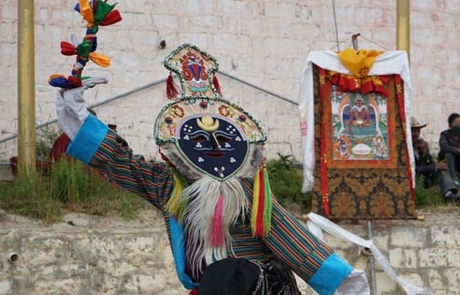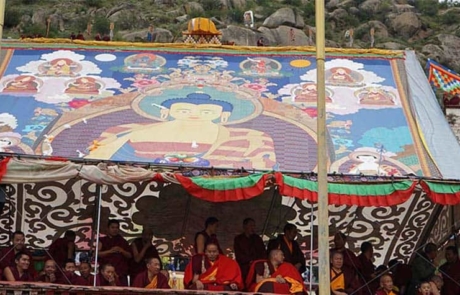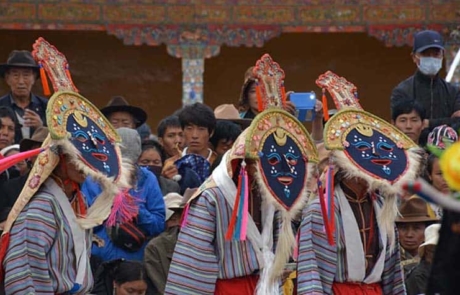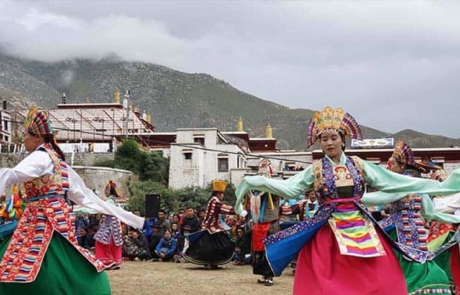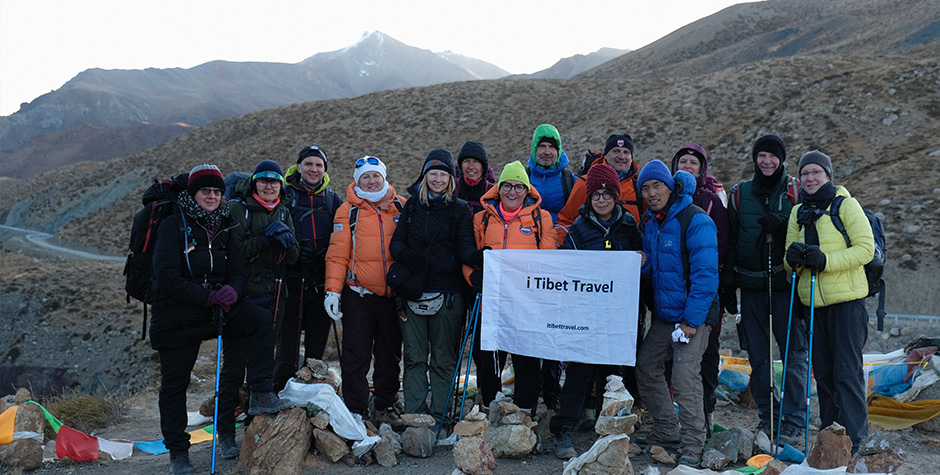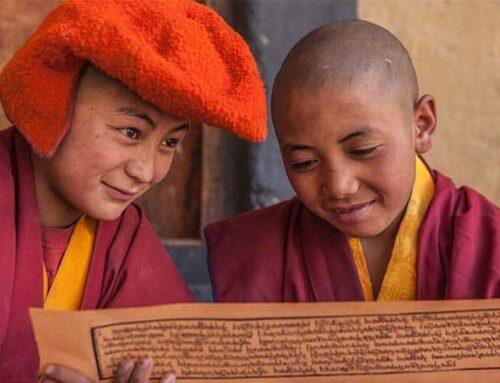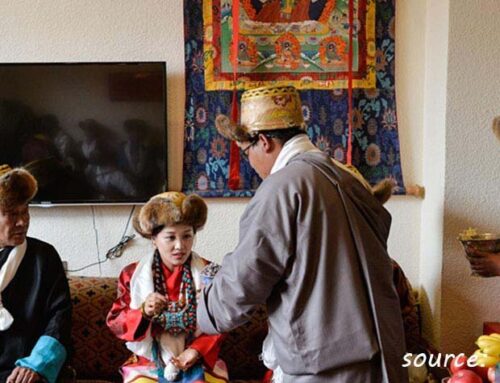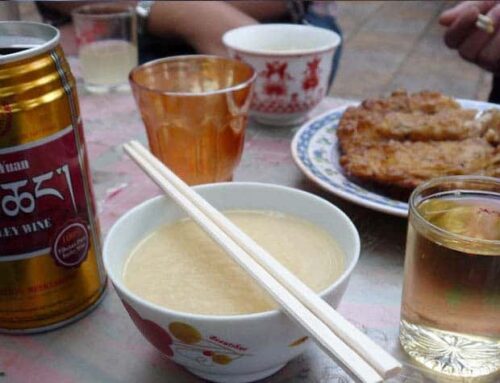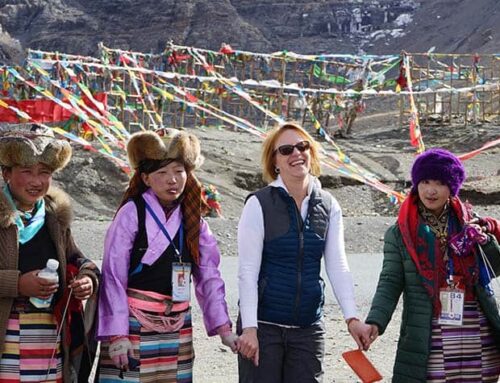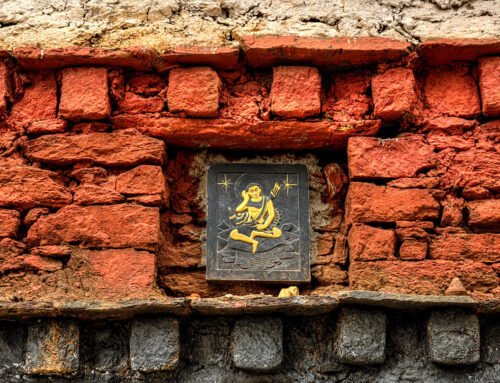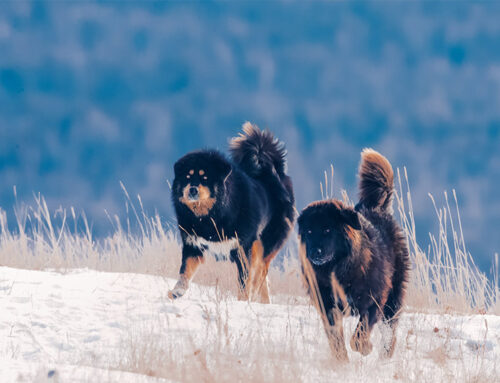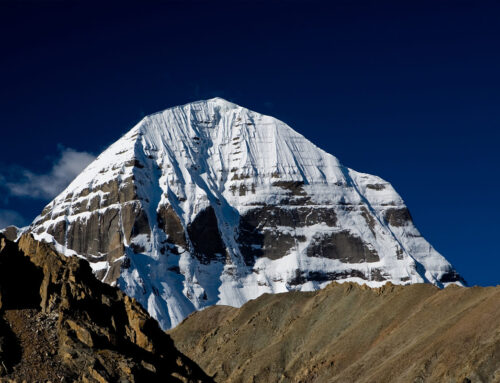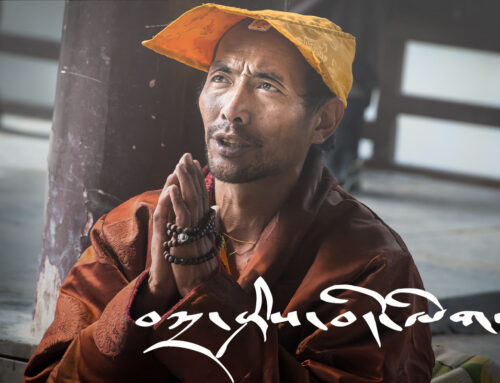Tibetan opera is known as Lhamo or Ache Lhamo in Tibetan. During your Tibet travel, you will often find the Tibetan opera performance in villages and if you visit Lhasa during the Lhasa Yogurt festival. The cultural wisdom of Tibetan for thousands of years and clearly reflected in the Tibetan opera. Many Tibetologists consider Tibetan opera as the living fossil of Tibetan culture.
Legend has it that in 14th mystic Thangtong Gyalpo found the culture of Tibetan opera to raise the fund for building iron bridge throughout the Tibetan Plateau. He received help from 12 sisters to perform in the Opera. Which are the first Ache Lhamo (Meaning sister goddess)?
Stories in Tibetan Opera
All the performance of the Tibetan Opera is base on some ancient Indian Buddhist folk tales. The Opera of Princess Wencheng is also base on the historical.
Another reason for his troupe to travel far and wide is to spread the teaching of Lord Buddha in the form of entertainment. Most of the stories of the performance are the hard work and struggle of the good people and the ultimate triumph of the good over the evil.
Right now there are nine major traditional Tibetan operas.
Performance of Tibetan Opera
The procedure and the performance style has not changed much since the 14th century. Nowadays, we follow the same opening rituals are enacted before the commencement of every performance, authentic costumes are worn, singing, dance, and musical tradition are strictly adhered to.
There is no much information about the development of Tibetan Opera until the time of 5th Dalai Lama. According to some source, it is said the mask and Custome of the hunter are designed by the fifth Dalai lama base on his dream. We have some wall mural about the Tibetan opera in The Potala Palace.
In the early 19th century, every county in Tibet has they own amateur troupe performing locally during different occasions. Most famous troupes are Tashi Sholpa of Shol village below Potala palace, Chongye Phundun of Chongye in Shanan Prefecture, Shangpa of Jang Village, Gyalkhara, Chungpa of Quxul village, and Kyormulung of Tulung county are the most popular. These troupe would regulation take part in the official festival in Norbulingka, Drepung Monastery and Sera Monastery.
Notable Troupes of Tibetan Opera
Notable troupes including Tashi Sholpa, Chongye Phundun, Shangpa, Gyalkhara, Chungpa, and Kyormulung have been much sought after. There are always a regular part of the official festivals at Norbulingka, Drepung Monastery, and Sera Monastery.
Tashi Sholpa
The Tashi Sholpa is the oldest and most popular of all the Tibetan Opera Troupe in Tibet. This troupe has their own dance for Good luck which is commonly performed during inaugurate special occasions such as big official gatherings and construction or opening or construction of a monastery. The performer would wear a whiteboard mask to represent Thantong Gyalpo, the founder of Tibetan Opera. Since he lives for 140 years, his representation symbolizes longevity and good health.
Opera Stories
Traditionally, there are nine different Tibetan opera performances. These stories are each exclusively played by the particular troupe. Sukyi Nima, Drowa Sangmo and Pema Woebar exclusively perform by the Kyormulung troupe. Prince Norsang is solely performed by Gyalkhara as their main performance because of their monastic background. The troupe from the Muru Monastery perform only Deep Tenpa. The Chungpa Troupe perform Drimed Kunden.
People from all walks of life in Tibetan are familiar with arias. They would often sing it during all the social gatherings, religious festivals and even while walking lonely in remote places
The background story of Tibetan opera and Thangtong Gyalpo
Thangtong Gyalpo, in 14th Century, started Tibetan Opera. He was born to a peasant family in Shigatse County in 1361. As a child, he was sent to the Local monastery to learn about Buddhist Philosophy. During his childhood in the monastery, he is a smart child and easily able to learn everything.
Motivations for Starting Tibetan Opera
Later he came to Lhasa to further his studies. In Lhasa, he found that d many people cannot cross the river in the boat because they don’t have money to pay for it. So he begs the boatmen to let these people cross for free of cost. However, instead of letting them cross for free, the boatmen have beaten Thangtong Gyalpo. After this incident, he has generated an extreme desire to build the bridge over the River.
Formation of Troupe
He selected seven sisters from his labour during the construction of a bridge at Chowo Ri. Then, he thought of their songs and dances. With them, he formed the first Tibetan opera troupe. Girls wearing beautiful costumes travelled around Tibet, performing to raise funds for the projects. The girls sang and danced while the yogi himself beat the Drum and cymbal. Tibetan were so impressed with the performance, and they hailed the girls as the goddess. Since then, they have been known as Ache Lhasa (Sister Goddess). After a while, the performance of Tibetan opera itself is called Ache Lhamo.
Iron Bridges and Tibetan Opera
The group was able to raise funds for 58 iron bridges and 60 wooden bridges across Tibet. Some of his iron bridges are still standing in different places in Tibet and Bhutan.
Now, in Tibet is custom for us to install statues and images of Yogi when we are occupying a new home. Moreover, during the Tibetan opera performances, it is custom to have a ritual dance and installation of his statues in the middle of the performance ground or stage and pay homages to him.
The Performance of the Tibetan Opera
Traditionally Tibetan Opera Or Ache Lhamo is usually performed outdoors on a circular stage where all the audience would sit around the circular stage to enjoy the show. The Stage may or may not have a tent above the stage.
Sequence of Tibetan Opera
Initially, all the members of the troupe would come to the stage to pay homage to the image or statue of Thangtong Gyalpo. follow by the dance of the Hunters (Ngonpa) while the Ngopas are dancing the auspicious dance. The seven Lhamos ( angels) and the Narrator will appear on the stage. After the dance, the narrator will initiate the play by narrating the part of the story. followed by song dance and singing of arias.
Subsequently, the actor would play the stories. During the play, they will be lots of jokes, singing and dancing as part of the story and audience.
By the end of the play usually with the victory of good over evil. There will be dance and song follow by the offering of incense to the god of the world out of gratitude.
Tibetan Opera in Modern Time.
Tibetan opera has been list intangible culture of Tibetan People and Chinese National by the UN, Central Government in Beijing and Regional Government of Tibet.
There have been many efforts from the Government at all levels to preserve and promote it. Now all the counties in Tibet, as they own troupe. They would have a competition every year in the Norbulingka for a week-long traditional Tibetan Holiday of Yoghurt festival in Lhasa.
Many schools in Lhasa has Tibetan opera class as the extra curriculum. The most popular story in the Tibetan opera in Tibet now is of Princess Wencheng. When you are in Lhasa, you can visit the Village Drip Tsechokling to see the live performance of Princess Wencheng.
About Tibet Travel & Tours
Tibet Travel & Tours is a local travel agency in Tibet that offers unique and authentic experiences to travelers from all around the world. As a leading tour operator in Tibet, we provide high-quality Tibet Travel services that are tailored to our clients’ needs and preferences.
Our team of experienced and knowledgeable professionals strives to ensure that our clients have a hassle-free and memorable trip in Tibet. We specialize in various types of tours, including cultural tours, trekking and hiking tours, and adventure tours.
Our commitment to providing exceptional service has earned us a reputation as one of the best local travel agencies in Tibet. Contact us today to plan your unforgettable trip to Tibet.
Explore Tibet with a local Tibetan Travel Agency
If you’re looking to explore Tibet, starting your journey with a reputable Tibetan travel agency in Tibet is crucial. Tibet Travel & Tours is a great choice to begin your adventure with their extensive knowledge of the region and commitment to responsible tourism.
Their Tibet tour packages cater to a range of interests and budgets, making it easy to plan a trip that suits your needs. Before embarking on your tibet tour, it’s essential to have the right Tibet travel information and necessary documents, including a Tibet travel permit.
The Tibet Travel Planner provided by i-Tibet travel is an excellent resource to plan your trip, including tips on what to pack, where to stay, and what to see.
For beginners, the “About Tibet” guide provided by i-Tibet travel offers a comprehensive overview of the region’s history, culture, and top attractions. So, start your Tibet travel plan here with i-Tibet travel and discover the magic of Tibet for yourself.

